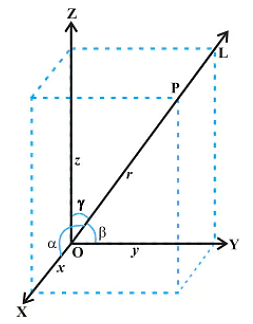Let the line $L: \frac{x-1}{2}=\frac{y+1}{-1}=\frac{z-3}{1}$ intersect the plane $2 x+y+3 z=16$ at the point $P$ Let the point $Q$ be the foot of perpendicular from the point $R(1,-1,-3)$ on the line $L$ If $\alpha$ is the area of triangle $P Q R$, then $\alpha^2$ is equal to
Let the line $L: \frac{x-1}{2}=\frac{y+1}{-1}=\frac{z-3}{1}$ intersect the plane $2 x+y+3 z=16$ at the point $P$ Let the point $Q$ be the foot of perpendicular from the point $R(1,-1,-3)$ on the line $L$ If $\alpha$ is the area of triangle $P Q R$, then $\alpha^2$ is equal to
Show Hint
Correct Answer: 180
Solution and Explanation
The correct answer is 180.
Any point on L((2λ+1),(−λ−1),(λ+3))
2(2λ+1)+(−λ−1)+3(λ+3)=16
6λ+10=16⇒λ=1
∴P=(3,−2,4)
DR of QR=⟨2λ,−λ,λ+6⟩
DR of L=⟨2,−1,1⟩
4λ+λ+λ+6=0
6λ+6=0⇒λ=−1
Q=(−1,0,2)

QR×QP=∣∣i^24j^−1−2k^−52∣∣=−12i^−24j^
α=21×144+576⇒α2=4720=180
Top Questions on Three Dimensional Geometry
- If A(2,1,-1), B(6,-3,2), C(-3,12,4) are the vertices of a triangle ABC and the equation of the plane containing the triangle ABC is $53x+by+cz+d=0$, then $\frac{d}{b+c}=$
- TS EAMCET - 2025
- Mathematics
- Three Dimensional Geometry
- If m:n is the ratio in which the point $\left(\frac{8}{5}, \frac{1}{5}, \frac{8}{5}\right)$ divides the line segment joining the points (2,p,2) and (p,-2,p) where p is an integer then $\frac{3m+n}{3n}=$
- TS EAMCET - 2025
- Mathematics
- Three Dimensional Geometry
- If $(\alpha, \beta, \gamma)$ is the foot of the perpendicular drawn from a point $(-1,2,-1)$ to the line joining the points $(2,-1,1)$ and $(1,1,-2)$, then $\alpha+\beta+\gamma=$
- TS EAMCET - 2025
- Mathematics
- Three Dimensional Geometry
- Let $\pi_1$ be the plane determined by the vectors $\hat{i}+\hat{j}, \hat{i}+\hat{k}$ and $\pi_2$ be the plane determined by the vectors $\hat{j}-\hat{k}, \hat{k}-\hat{i}$. Let $\vec{a}$ be a non-zero vector parallel to the line of intersection of the planes $\pi_1$ and $\pi_2$. If $\vec{b} = \hat{i}+\hat{j}-\hat{k}$ then the angle between the vectors $\vec{a}$ and $\vec{b}$ is
- TS EAMCET - 2025
- Mathematics
- Three Dimensional Geometry
Show that the following lines intersect. Also, find their point of intersection:
Line 1: \[ \frac{x - 1}{2} = \frac{y - 2}{3} = \frac{z - 3}{4} \]
Line 2: \[ \frac{x - 4}{5} = \frac{y - 1}{2} = z \]
- CBSE CLASS XII - 2025
- CBSE Compartment XII - 2025
- Mathematics
- Three Dimensional Geometry
Questions Asked in JEE Main exam
- Find the equivalent resistance between two ends of the following circuit:

- JEE Main - 2025
- Current electricity
Given below are two statements. One is labelled as Assertion (A) and the other is labelled as Reason (R):
Assertion (A): In an insulated container, a gas is adiabatically shrunk to half of its initial volume. The temperature of the gas decreases.
Reason (R): Free expansion of an ideal gas is an irreversible and an adiabatic process.In the light of the above statements, choose the correct answer from the options given below:
- JEE Main - 2025
- Current electricity
- Find the output voltage in the given circuit.

- JEE Main - 2025
- Current electricity
- A wire of length $ 25 \, \text{m} $ and cross-sectional area $ 5 \, \text{mm}^2 $ having resistivity $ 2 \times 10^{-6} \, \Omega \cdot \text{m} $ is bent into a complete circle. The resistance between diametrically opposite points will be:
- JEE Main - 2025
- Current electricity
Current passing through a wire as function of time is given as $I(t)=0.02 \mathrm{t}+0.01 \mathrm{~A}$. The charge that will flow through the wire from $t=1 \mathrm{~s}$ to $\mathrm{t}=2 \mathrm{~s}$ is:
- JEE Main - 2025
- Current electricity
Concepts Used:
Three Dimensional Geometry
Mathematically, Geometry is one of the most important topics. The concepts of Geometry are derived w.r.t. the planes. So, Geometry is divided into three major categories based on its dimensions which are one-dimensional geometry, two-dimensional geometry, and three-dimensional geometry.
Direction Cosines and Direction Ratios of Line:
Consider a line L that is passing through the three-dimensional plane. Now, x,y and z are the axes of the plane and α,β, and γ are the three angles the line makes with these axes. These are commonly known as the direction angles of the plane. So, appropriately, we can say that cosα, cosβ, and cosγ are the direction cosines of the given line L.
